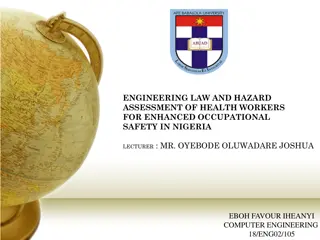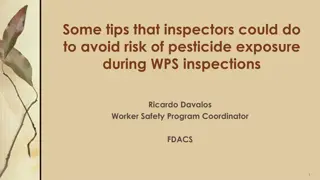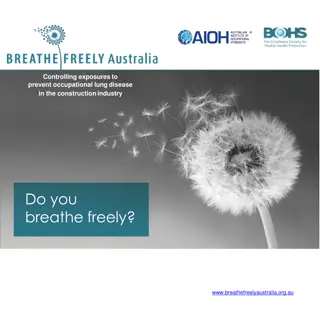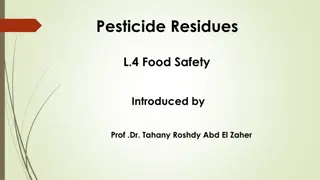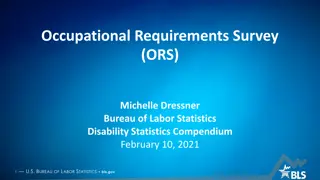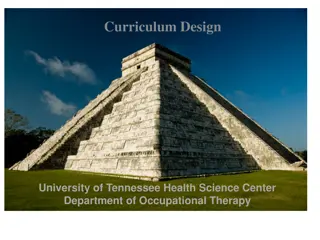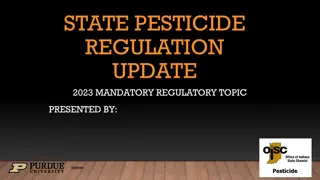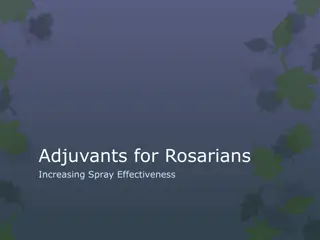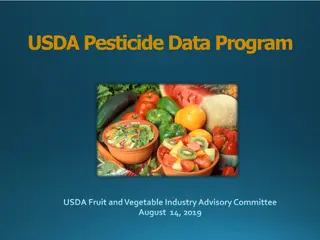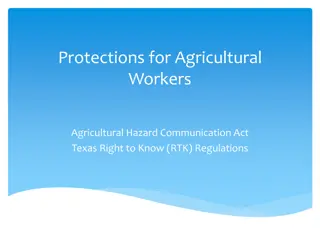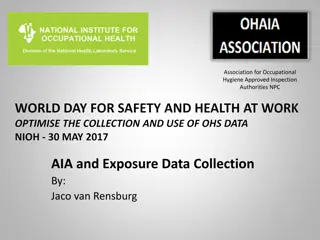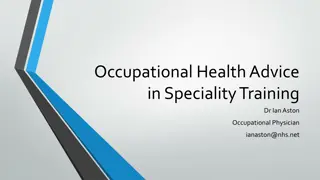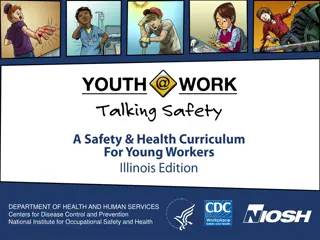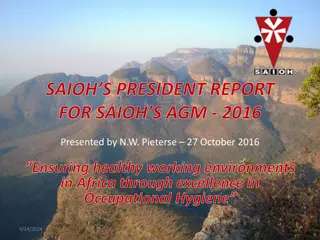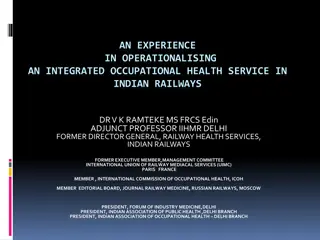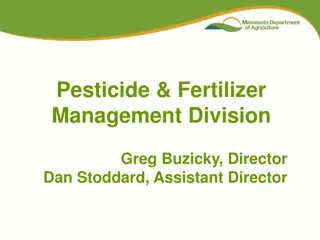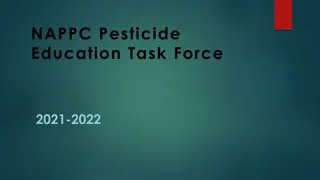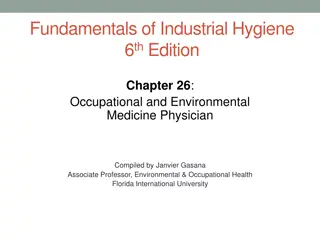Occupational Pesticide Safety and Health Concerns
Occupational safety and health issues related to pesticide exposure are a significant concern globally. Limited surveillance data on pesticide exposure and related illnesses are available, with a high percentage of farmers being affected annually. Various occupations beyond farming also face potential pesticide exposure risks. The need for continued surveillance and prevention strategies is emphasized to mitigate the risks associated with pesticide exposure in occupational settings.
Download Presentation

Please find below an Image/Link to download the presentation.
The content on the website is provided AS IS for your information and personal use only. It may not be sold, licensed, or shared on other websites without obtaining consent from the author. Download presentation by click this link. If you encounter any issues during the download, it is possible that the publisher has removed the file from their server.
E N D
Presentation Transcript
National Institute for Occupational Safety and Health Current, Emerging and Re-emerging Issues in Occupational Safety and Health Ketki Patel, MD, PhD, MPH Manager, Environmental Surveillance and Toxicology Branch, Texas Department of State Health Surveillances
Disclaimer The findings and conclusions in this presentation are those of the author(s) and do not necessarily represent the official position of the National Institute for Occupational Safety and Health, Centers for Disease Control and Prevention
Current Issues in Occupational Safety and Health Surveillance Pesticide-related injury and illness
Pesticides A pesticide is any substance or mixture of substances intended for Preventing, destroying, repelling or mitigating any pest. Use as a plant regulator, defoliant, or desiccant. Use as a nitrogen stabilizer Image Source: https://secure.flickr.com/photos/usdagov/46790417815/in /album-72157706329251631/ Source: United States Environmental Protection Agency (EPA). https://www.epa.gov/ingredients-used-pesticide-products/basic-information-about- pesticide-ingredients
Need for continued surveillance and prevention Limited occupational surveillance data on pesticide exposure and related illness available in most countries. Globally, 44% percent farmers are affected by pesticide poisoning each year.1 The U.S. Bureau of Labor Statistics Current Population Survey estimated over 1.1 million workers employed in farming occupations in 2019.2 Several other occupations and industry groups have potential for exposure to pesticides such as veterinarians, animal handlers, landscapers, maintenance workers, cleaners and janitorial services, lawn/pest service providers, air crews, etc. Source: 1. Boedeker, W., Watts, M., Clausing, P., & Marquez, E. (2020). The global distribution of acute unintentional pesticide poisoning: estimations based on a systematic review. BMC public health, 20(1), 1-19. 2. National Institute for Occupational Safety and Health. Centers for Disease Control and Prevention. Employed Labor Force (ELF) query system. https://wwwn.cdc.gov/Wisards/cps/cps_estimates_results.aspx
Occupational Pesticide Safety and Health in the U.S. 40 CFR, Part 170 Worker Protection Standard Reduce the risks of illness or injury resulting from workers' and handlers' occupational exposures to pesticides used in the production of agricultural plants on farms or in nurseries, greenhouses, and forests and also from the accidental exposure of workers and other persons to such pesticides. It requires workplace practices designed to reduce or eliminate exposure to pesticides and establishes procedures for responding to exposure-related emergencies. Image source: https://phil.cdc.gov/Details.aspx?pid=11492
Occupational Pesticide Safety and Health in the U.S. Surveillance efforts: National Poison Data System US EPA NIOSH SENSOR-Pesticides Program Image Source: https://www.cdc.gov/niosh/topics/pesticides/animatedmap.html
State-based Pesticide-related Injury and Illness Surveillance The NIOSH-SENSOR Pesticides model: Provides guidance and training to build state capacity Allows states to focus on their priority populations and areas for improvement in surveillance and prevention Provides more timely data for interventions Fosters local, state, and federal partnerships
State-based Pesticide-related Injury and Illness Surveillance Challenges and work-in-progress: Underreporting Vulnerable and hard-to-reach worker populations Language and cultural barriers Knowledge and awareness on safe use, storage and disposal of pesticide products Resources
Emerging Issues in Occupational Safety and Health Surveillance Coronavirus Disease 2019 (COVID-19) pandemic
Timeline of COVID-19 Pandemic 12/20/2020- present day Several variants of SARS-CoV-2 emerged; cases have been reported in many countries 3/15/20 States & U.S. territories begin to issue statewide stay-at- home orders 3/11/20 WHO declared COVID-19 as a Pandemic 1/21/20 1st case of COVID-19 2/3/20 3/13/20 12/11/20201 2/18/2020 FDA EUA* for two COVID- 19 Vaccinesa 2/27/2021 FDA EUA* for third vaccineb Declared public health emergency COVID-19 declared as a National Emergency *EUA= Emergency Use Authorization. a EUA for Pfizer BioNTech and Moderna COVID-19 vaccines. b EUA for J&J COVID-19 vaccine
COVID-19 and Critical Infrastructure Workforce Cybersecurity and Infrastructure Security Agency (CISA) identifies 16 critical infrastructure sectors whose assets, systems, and networks, whether physical or virtual, are considered so vital to the United States that their incapacitation or destruction would have a debilitating effect on security, national economic security, national public health or safety, or any combination thereof Source: https://www.cisa.gov/identifying-critical-infrastructure-during-covid-19
COVID-19 and State-based Occupational Health Surveillance and Prevention Case Investigation and Contact Tracing Technical Assistance o Industry and occupation data collection and coding o Collecting other details about work/job tasks Workplace Outbreaks Facility assessments and epidemiologic investigations Education and outreach Capacity building Technical assistance & expert consultations to employers and businesses
COVID-19 and State-based Occupational Health Surveillance and Prevention Vaccination Efforts Workforce data o By industry and occupation groups, high-risk for severe illness o Capacity building Education and outreach Other support & logistics Guidance for purchase, and correct use of appropriate personal protective equipment as well as disinfection and cleaning products* Additional surveillance for COVID-19 pandemic related exposures and issues (for example: pesticide and chemical exposures) * Based on most update guidance from CDC/NIOSH, FDA Emergency Use Authorizations for PPE, and EPA N-List for Disinfectants.
Council of State and Territorial Epidemiologists (CSTE) CSTE COVID-19 Outbreak Workgroup Outbreak definitions and interim guidance for further investigation: Non-residential, non-healthcare workplace settings Educational settings Healthcare settings (collaborative effort with CORHA* members) Acute care Long term care facilities CSTE Occupational Health Subcommittee Additional guidance and tools: Epidemiological Classification of COVID-19 Work-relatedness and Documentation of Public-facing Occupations SARS-CoV-2 Occupational Exposure Risk Matrix or SOEM using O*NET * CORHA: The Council for Outbreak Response: Healthcare-Associated Infections and Antimicrobial-Resistant Pathogens.
COVID-19 and Occupational Health Surveillance and Prevention Improved visibility and awareness on Occupational Health Strengthened and new partnerships, local and federal New or enhanced tools, resources and skills New evidence on infectious disease (COVID-19) outbreaks in workplaces Better understanding about communities and businesses
Re-emerging Issues in Occupational Safety and Health Surveillance Occupational Lung Disease - Silicosis
Silicosis Results from inhalation of silicon dioxide or by exposure to respirable crystalline silica Occupational Exposures to Silica: Mining Sandblasting Quarrying Rock Drilling Manufacturing Agricultural Industries Stone Masonry Glass Manufacturing Construction Image source: https://phil.cdc.gov/Details.aspx?pid=227 95
Hawks Nest Tunnel Tragedy (1930-31) Image Source: https://img.ehstoday.com/files/base/ebm/ehstoday/image/2019/03/ehstoday_4244_ha wks_nest_workers.png?w=768 Image Source: https://img.ehstoday.com/files/base/ebm/ehstoday/image/2019/03/ehstoday_4248_mi ner_0.png?w=768
Post-war Economy and Silicosis Several cases of silicosis were identified among workers in shipyards, offshore oil rigs and oil refineries in Louisiana, Texas, and Mississippi in 1970-80s.1,2 U.S. Occupational Safety and Health Administration (OSHA): Established a Special Emphasis Program for Silicosis in 1996, which was later expanded to a National Emphasis Program in 2008, cancelled in 2017, and re- implemented in 20203 1. 2. 3. Rosner, D., Markowitz, G., Kroll-Smith, S., Brown, P., & Gunter, V. J. (2000). Illness and the Environment. Rosner, D., Markowitz, G., & Markowitz, G. E. (2006).Deadly dust: Silicosis and the on-going struggle to protect workers' health. University of Michigan Press. OSHA. National Emphasis Program Respirable Crystalline Silica https://www.osha.gov/sites/default/files/enforcement/directives/CPL_03-00-023.pdf
Occupational Lung Disease Surveillance and Prevention NIOSH s Work-related Lung Disease Surveillance System (eWoRLD) NIOSH s National Occupational Mortality Surveillance (NOMS) program State-based Surveillance California, Connecticut, Massachusetts, Michigan, New Jersey, New Mexico, New York, Oregon, Texas, Washington, Wisconsin
Silicosis Associated with Artificial (Engineered) Stone In recent years, state-based occupational health surveillance programs have identified several cases silicosis and silicosis-related deaths among workers in engineered stone countertop manufacturing and fabrication in the U.S. 1 Researchers have found similar cases of silicosis in engineered stone workers globally, often with rapid progression of disease. 3-5 1. Rose C, Heinzerling A, Patel K, et al. Severe Silicosis in Engineered Stone Fabrication Workers California, Colorado, Texas, and Washington, 2017 2019. MMWR Morb Mortal Wkly Rep 2019;68:813 818. DOI: http://dx.doi.org/10.15585/mmwr.mm6838a1 Hoy, R. F., Glass, D. C., Dimitriadis, C., Hansen, J., Hore-Lacy, F., & Sim, M. R. (2021). Identification of early-stage silicosis through health screening of stone benchtop industry workers in Victoria, Australia. Occupational and environmental medicine, 78(4), 296-302. Le n-Jim nez, A., Hidalgo-Molina, A., Conde-S nchez, M. ., P rez-Alonso, A., Morales-Morales, J. M., Garc a-G mez, E. M., & C rdoba-Do a, J. A. (2020). Artificial stone silicosis: rapid progression following exposure cessation. Chest, 158(3), 1060-1068. Leso, V., Fontana, L., Romano, R., Gervetti, P., & Iavicoli, I. (2019). Artificial stone associated silicosis: a systematic review. International journal of environmental research and public health, 16(4), 568. Hoy, R. F., Baird, T., Hammerschlag, G., Hart, D., Johnson, A. R., King, P., ... & Yates, D. H. (2018). Artificial stone-associated silicosis: a rapidly emerging occupational lung disease. Occupational and environmental medicine, 75(1), 3-5. 2. 3. 4. 5.
Challenges in State-based Surveillance and Prevention Diverse workforce, rapidly evolving work processes, work organization (non-standard work arrangements, contingent workers) Underreporting/ under recording Access to quality data Limited exposure and health outcomes data Hard-to-reach worker populations Cultural and language barriers Resources Image source: http://edwinmoindi.blogspot.com/2014/08/the-falacy-that- is-public-education-are.html
Road forward: Opportunities for surveillance, research and prevention Strategic partnerships Capacity building Improving state and national-level surveillance for silicosis as well as other occupational respiratory diseases Innovative methods for educational interventions: Use of digital and social media Targeted outreach to health care providers, employers and businesses, and worker populations
For more information, contact CDC 1-800-CDC-INFO (232-4636) TTY: 1-888-232-6348 www.cdc.gov The findings and conclusions in this report are those of the authors and do not necessarily represent the official position of the Centers for Disease Control and Prevention.



